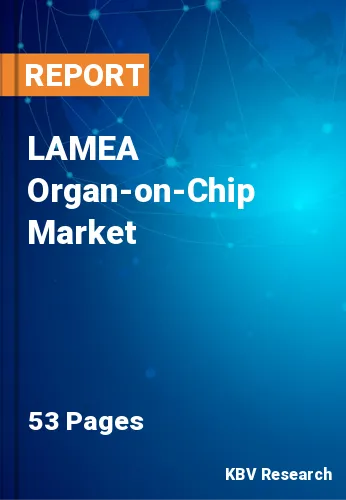The Latin America, Middle East and Africa Organ-on-Chip Market would witness market growth of 34.6% CAGR during the forecast period (2022-2028).
The use of microfluidics in organs-on-chips facilitates the efficient transport as well as distribution of nutrients along with other soluble cues throughout the live 3D tissue constructions. Organs-on-chips are described to represent the next wave of 3D cell-culture models that imitate full living organs' dynamic mechanical qualities, biological activities, and biochemical functionality.
Organotypic brain segments are an in vitro paradigm that simulates in vivo physiology with enhanced throughput and visual benefits, and hence they combine well with microfluidic devices. Brain slices have advantages over primary cell cultures because the tissue architecture is retained and multicellular interactions are still possible. There is versatility in their use, as slices can be employed acutely or cultivated for later experimental use. Because organotypic brain slices can maintain viability for weeks, they enable the examination of long-term consequences.
Slice-based systems also enable experimental access and precise control of external environments, making them an ideal platform for linking disease with neuropathological outcomes. Due to the fact that around 10 to 20 slices may be taken from a single brain, the utilization of animals is drastically decreased in comparison to in vivo research. Organotypic brain slices can be harvested and cultivated from a variety of animal species, including humans.
The region has a number of under-developed countries, in which, governments are significantly increasing their efforts in order to bring new growth prospects within the country. In regional nations, such as South Africa and Brazil, the demand for advanced and more effective pharmaceutical services and technologies is frequently increasing. Therefore, this factor is also playing a major role in fueling the adoption of organ-on-chip. These factors are stimulating the growth of the regional organ-on-chip market.
The Brazil market dominated the LAMEA Organ-on-Chip Market by Country in 2021; thereby, achieving a market value of $12,288.3 Thousands by 2028. The Argentina market is showcasing a CAGR of 35.3% during (2022 - 2028). Additionally, The UAE market would register a CAGR of 34.2% during (2022 - 2028).
Based on Type, the market is segmented into Lung on chip, Heart on chip, Human on chip, Kidney on chip, Liver on chip, and Intestine on chip. Based on countries, the market is segmented into Brazil, Argentina, UAE, Saudi Arabia, South Africa, Nigeria, and Rest of LAMEA.
Free Valuable Insights: The Global Organ-on-Chip Market is Predict to reach $815.6 Million by 2028, at a CAGR of 30.2%
The market research report covers the analysis of key stake holders of the market. Key companies profiled in the report include AxoSim, Inc., Visikol, Inc., CN Bio Innovations Limited., Elveflow (Elvesys Group), Emulate, Inc., Insphero AG, Mimetas B.V., Nortis Inc., Organovo Holdings, Inc. and TARA Biosystems, Inc.
By Type
By Country
Our team of dedicated experts can provide you with attractive expansion opportunities for your business.

